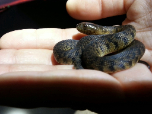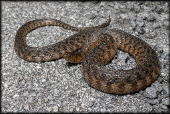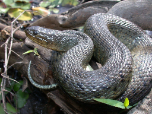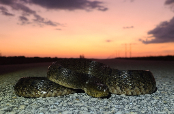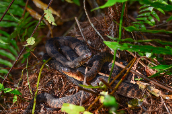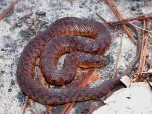Florida Green Water Snake (Nerodia floridana)
Description: N. floridana is the largest watersnake in North America. Fully grown it will typically reach 30–55 inches in total length (including tail), with the record-sized specimen having measured 74 inches in total length. Its coloration is solid grey or greenish-brownish with a white or yellow belly in adults, which darkens in color under the tail. Encircling the lower half of the eye is a row of scales, which is separate from the upper lip scales. Among all southeastern U.S. snakes, only the green water snake has this feature. Juveniles have typically, about 50 dark crossbars on the dorsum and on the sides, which fade gradually with age.
Habitat: It prefers choked vegetation and calm waters such as swamps and marshes. It is also generally found in lakes, ponds, ditches, and occasionally in brackish water.
Range: This species is endemic to the southeast of the United States. Its range encompasses the Coastal Plain from South Carolina disjunctly to southern Florida, and west through southern Georgia and the Florida panhandle to a small portion of southern Alabama (Mount 1975, Gibbons and Dorcas 2004); the species is apparently absent from most of southeastern Georgia.
Found in these States:
AL |
FL |
GA |
SC
Diet: Little is known about the diet of N. floridana. Most reports suggest that its diet consists primarily of fish, including sunfish, crappies, and small bass. It also preys upon frogs, especially pig frogs, tadpoles, and salamanders. Little is known about its methods for finding prey, but like other water snakes, N. floridana swallows its prey alive.
Reproduction: N. floridana bears live young by ovoviviparity similar to other North American water snakes. A few observations have been made of matings in late winter or early spring. Females generally have very large litters and give birth in the summer. The size of the litter ranges from 20 to 40, and the young are typically born from June to September.
Status: Listed as Least Concern in view of its reasonably wide distribution, tolerance of a degree of habitat modification, presumed large population, and because it is unlikely to be declining fast enough to qualify for listing in a more threatened category.
»» Kingdom: Animalia - Animals
»» Phylum: Chordata - Chordates
»» Subphylum: Vertebrata - Vertebrates
»» Class: Reptilia - Reptiles
»» Order: Squamata - Scaled Reptiles
»» Suborder: Serpentes
»» Superfamily: Colubroidea
»» Family: Colubridae - Colubrids
»» Genus: Nerodia
»» Species: Nerodia floridana - Florida Green Water Snake
This article uses material from the Wikipedia article "Nerodia floridana", which is released under the Creative Commons Attribution-Share-Alike License 3.0. Content may have been omitted from the original, but no content has been changed or extended.
|


